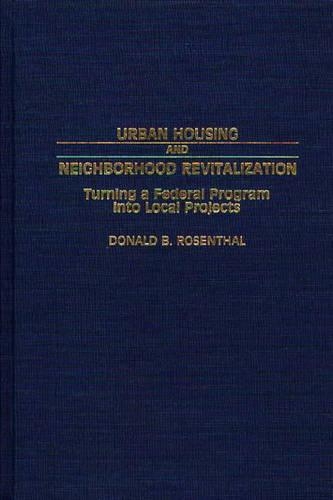
Urban Housing and Neighborhood Revitalization: Turning a Federal Program into Local Projects
(Hardback)
Publishing Details
Urban Housing and Neighborhood Revitalization: Turning a Federal Program into Local Projects
By (Author) Donald Rosenthal
Bloomsbury Publishing PLC
Praeger Publishers Inc
7th July 1988
United States
Classifications
Tertiary Education
Non Fiction
307.140973
Physical Properties
Hardback
238
Description
Although many scholars have emphasized the shortcomings of federal housing programs, few have examined their successes and failures on a case-by-case empirical basis. With the possibility that federal involvement in housing may increase in the future, we need to have more precise knowledge of what works, what does not, and why. Donald Rosenthal's new book is the first study to focus on the Section 8 Neighborhood Strategy Area program (NSA)--one of the last major housing initiatives of the Carter administration. Reporting on his extensive field research, the author examines the development and implementation of the program and documents its results. In the process, he provides valuable new insights on American intergovernmental relations between 1977 and 1984 and traces the evolution of federal policy on assisted housing and community development under the Carter and Reagan administrations.
Reviews
The author examines the Section 8 Neighborhood Strategy Area program, a federal housing program for low-income individuals, to help explain the relations between the federal and local governments. Five analytical models of intergovernmental relations are used to discuss what took place between the federal government and 118 communities during the six years of program operation (1978-1983). Differences between the Reagan and Carter administrations highlight how changes in ideology and ruling parties can affect program governance. The author concludes that the program was a step forward, but that it was in no way reflective of a national housing policy.-Journal of Planning Literature
"The author examines the Section 8 Neighborhood Strategy Area program, a federal housing program for low-income individuals, to help explain the relations between the federal and local governments. Five analytical models of intergovernmental relations are used to discuss what took place between the federal government and 118 communities during the six years of program operation (1978-1983). Differences between the Reagan and Carter administrations highlight how changes in ideology and ruling parties can affect program governance. The author concludes that the program was a step forward, but that it was in no way reflective of a national housing policy."-Journal of Planning Literature
Author Bio
DONALD B. ROSENTHAL is Professor and Chair of the Department of Political Science at the State University of New York at Buffalo.
